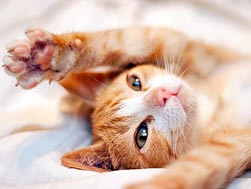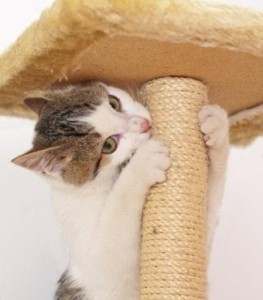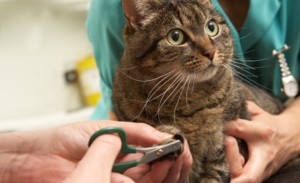Today’s topic has a bit of a serious note to it, but it is something we feel strongly about discussing. Let’s talking about declawing cats:
If you aren’t familiar with declawing, it is when an owner chooses to have their cat’s claws surgically removed to prevent them from scratching on furniture. Declawing is often mistaken as a harmless “quick fix” to prevent a cat from participating in a seemingly frivolous and annoying behavior. What many people don’t realize is that declawing is actually a painful procedure that can lead to several behavioral and medical difficulties in a cat.
Declawing has been banned in several countries and is supremely opposed by the Humane Society of the United states except for extremely rare cases when it is necessary for medical purposes such as the removal of cancerous tissue.
The truth about scratching is that it is a natural cat behavior. Cats don’t intend to destroy furniture and are not vindictively “getting even” with their owners by marking up their chairs, walls, or other materials in the home. Scratching is an innate behavior cats participate in to remove the dead husks from their claws, mark their territory, and stretch their muscles. They typically begin this behavior at around 8 weeks old, which is the prime time to teach a cat that scratching on appropriate things such as scratching posts is a good option and that nail trims are not torture.
The truth about declawing is that it is NOT equivalent to a nail trim. Declawing is a surgical procedure that involves the amputation of the last bone of each toe. It is the equivalent to amputating a human’s last knuckle on each of their fingers. This toe amputation can leave a cat with long term risks such as permanent lameness and pain. It can also lead to infection, dead tissue, nerve damage, bone spurs, and even a regrowth of improperly removed claws. Typically, after the procedure, cats are given litter boxes with shredded newspaper to prevent irritation or infection of the newly declawed feet. This quick change of litter substrate, along with the pain from scratching in the litter box, can often lead to future litter box issues. Some cats even stop using their box altogether. Declawed cats often have to find other ways to defend themselves since they can no longer scratch as a warning, and become biters. Often, because of the pain associated with this procedure, declawed cats often have serious behavioral issues and are immeasurably never the same temperament-wise. Some have to be on pain medication for the rest of their lives.
So, what are the alternatives? There are so many ways to limit unwanted scratching in your house! Firstly, always keep your cat’s claws trimmed to the appropriate length. If you have difficulties cutting your cat’s nails, make frequent vet or groomer appointments for them to keep up with the growth. Secondly, provide appropriate scratching surfaces around your home! Provide a variety of materials such as carpet, sisal, wood, cardboard, and anything else your can seems to like. Use toys and catnip to entice your kitty to scratch on those surfaces instead of your couch! Thirdly, ask your vet or groomer about soft plastic nail caps such as Soft Paws. These can be applied with glue to your cat’s nails every six weeks or so by a groomer or vet, or you can be bold and apply them yourself! And lastly, if your cat seems to have a particular affinity to scratching your furniture, apply sticky tape to the area. Cats don’t love putting their paws on sticky areas, and will cease to scratch on the taped area.
We hope this post was eye-opening and informative for you! If you have any questions about scratching issues with your cat, please ask your vet!








